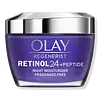What's inside
What's inside
 Key Ingredients
Key Ingredients

 Benefits
Benefits

 Concerns
Concerns

 Ingredients Side-by-side
Ingredients Side-by-side

Water
Skin ConditioningDimethicone
EmollientGlycerin
HumectantTapioca Starch
Dimethicone Crosspolymer
Emulsion StabilisingRetinol
Skin ConditioningRetinyl Propionate
Skin ConditioningNiacinamide
SmoothingPalmitoyl Pentapeptide-4
Skin ConditioningPolyacrylamide
C13-14 Isoparaffin
EmollientDMDM Hydantoin
PreservativePolysorbate 20
EmulsifyingLaureth-4
EmulsifyingAcrylates/C10-30 Alkyl Acrylate Crosspolymer
Emulsion StabilisingLaureth-7
EmulsifyingDimethiconol
EmollientPolymethylsilsesquioxane
Aminomethyl Propanol
BufferingTitanium Dioxide
Cosmetic ColorantDisodium EDTA
Iodopropynyl Butylcarbamate
PreservativeCaprylic/Capric Triglyceride
MaskingAminopeptidase
Skin ConditioningWater, Dimethicone, Glycerin, Tapioca Starch, Dimethicone Crosspolymer, Retinol, Retinyl Propionate, Niacinamide, Palmitoyl Pentapeptide-4, Polyacrylamide, C13-14 Isoparaffin, DMDM Hydantoin, Polysorbate 20, Laureth-4, Acrylates/C10-30 Alkyl Acrylate Crosspolymer, Laureth-7, Dimethiconol, Polymethylsilsesquioxane, Aminomethyl Propanol, Titanium Dioxide, Disodium EDTA, Iodopropynyl Butylcarbamate, Caprylic/Capric Triglyceride, Aminopeptidase
Water
Skin ConditioningDimethicone
EmollientGlycerin
HumectantAlcohol Denat.
AntimicrobialPEG-8
HumectantDipropylene Glycol
HumectantSaccharomyces/Xylinum/Black Tea Ferment
Skin ConditioningPropylene Glycol
HumectantPolysilicone-11
Bis-PEG-18 Methyl Ether Dimethyl Silane
EmollientTuber Aestivum Extract
Skin ProtectingTuber Melanosporum Extract
HumectantAdenosine
Skin ConditioningCapryloyl Salicylic Acid
ExfoliatingNeohesperidin Dihydrochalcone
MaskingSodium Hyaluronate
HumectantTrisodium Ethylenediamine Disuccinate
Tocopherol
AntioxidantOctyldodecanol
EmollientSqualane
EmollientAmmonium Polyacryloyldimethyl Taurate
Emulsion StabilisingBiosaccharide Gum-4
Skin ConditioningBiotin
AntiseborrhoeicCaprylyl Glycol
EmollientCitric Acid
BufferingHydroxyethylcellulose
Emulsion StabilisingPEG-20 Methyl Glucose Sesquistearate
EmulsifyingSodium Citrate
BufferingXanthan Gum
EmulsifyingBis-PEG/PPG-16/16 PEG/PPG-16/16 Dimethicone
EmollientCaprylic/Capric Triglyceride
MaskingBenzyl Alcohol
PerfumingHexyl Cinnamal
PerfumingHydroxycitronellal
PerfumingCI 14700
Cosmetic ColorantCI 19140
Cosmetic ColorantPentaerythrityl Tetra-Di-T-Butyl Hydroxyhydrocinnamate
AntioxidantPhenoxyethanol
PreservativePotassium Sorbate
PreservativeSodium Benzoate
MaskingSodium Salicylate
PreservativeParfum
MaskingWater, Dimethicone, Glycerin, Alcohol Denat., PEG-8, Dipropylene Glycol, Saccharomyces/Xylinum/Black Tea Ferment, Propylene Glycol, Polysilicone-11, Bis-PEG-18 Methyl Ether Dimethyl Silane, Tuber Aestivum Extract, Tuber Melanosporum Extract, Adenosine, Capryloyl Salicylic Acid, Neohesperidin Dihydrochalcone, Sodium Hyaluronate, Trisodium Ethylenediamine Disuccinate, Tocopherol, Octyldodecanol, Squalane, Ammonium Polyacryloyldimethyl Taurate, Biosaccharide Gum-4, Biotin, Caprylyl Glycol, Citric Acid, Hydroxyethylcellulose, PEG-20 Methyl Glucose Sesquistearate, Sodium Citrate, Xanthan Gum, Bis-PEG/PPG-16/16 PEG/PPG-16/16 Dimethicone, Caprylic/Capric Triglyceride, Benzyl Alcohol, Hexyl Cinnamal, Hydroxycitronellal, CI 14700, CI 19140, Pentaerythrityl Tetra-Di-T-Butyl Hydroxyhydrocinnamate, Phenoxyethanol, Potassium Sorbate, Sodium Benzoate, Sodium Salicylate, Parfum
 Reviews
Reviews

Ingredients Explained
These ingredients are found in both products.
Ingredients higher up in an ingredient list are typically present in a larger amount.
This ingredient is an emollient, solvent, and texture enhancer. It is considered a skin-softener by helping the skin prevent moisture loss.
It helps thicken a product's formula and makes it easier to spread by dissolving clumping compounds.
Caprylic Triglyceride is made by combining glycerin with coconut oil, forming a clear liquid.
While there is an assumption Caprylic Triglyceride can clog pores due to it being derived from coconut oil, there is no research supporting this.
Learn more about Caprylic/Capric TriglycerideDimethicone is a type of synthetic silicone created from natural materials such as quartz.
What it does:
Dimethicone comes in different viscosities:
Depending on the viscosity, dimethicone has different properties.
Ingredients lists don't always show which type is used, so we recommend reaching out to the brand if you have questions about the viscosity.
This ingredient is unlikely to cause irritation because it does not get absorbed into skin. However, people with silicone allergies should be careful about using this ingredient.
Note: Dimethicone may contribute to pilling. This is because it is not oil or water soluble, so pilling may occur when layered with products. When mixed with heavy oils in a formula, the outcome is also quite greasy.
Learn more about DimethiconeGlycerin is already naturally found in your skin. It helps moisturize and protect your skin.
A study from 2016 found glycerin to be more effective as a humectant than AHAs and hyaluronic acid.
As a humectant, it helps the skin stay hydrated by pulling moisture to your skin. The low molecular weight of glycerin allows it to pull moisture into the deeper layers of your skin.
Hydrated skin improves your skin barrier; Your skin barrier helps protect against irritants and bacteria.
Glycerin has also been found to have antimicrobial and antiviral properties. Due to these properties, glycerin is often used in wound and burn treatments.
In cosmetics, glycerin is usually derived from plants such as soybean or palm. However, it can also be sourced from animals, such as tallow or animal fat.
This ingredient is organic, colorless, odorless, and non-toxic.
Glycerin is the name for this ingredient in American English. British English uses Glycerol/Glycerine.
Learn more about GlycerinWater. It's the most common cosmetic ingredient of all. You'll usually see it at the top of ingredient lists, meaning that it makes up the largest part of the product.
So why is it so popular? Water most often acts as a solvent - this means that it helps dissolve other ingredients into the formulation.
You'll also recognize water as that liquid we all need to stay alive. If you see this, drink a glass of water. Stay hydrated!
Learn more about Water